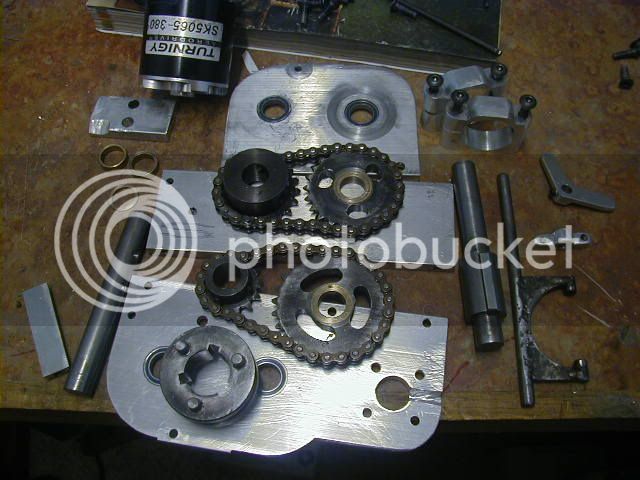michaelplogue
10 kW
Wasn't sure where to put this, so figured this section was a safe bet.
I was sitting this morning - having a cup of coffee - and trying to think of a way to set up a two-speed gearing mechanism. This is what I came up with - not sure if it's viable - comments would be very welcome!

So, basically we've got two motors spinning a common jack-shaft - though this would work for any number of motors. On the jack-shaft, you have a free floating 'swing-arm' (in blue below) that's mounted via bearings to this shaft. You also have a smaller pulley that spins the green bits (pulley and cog). For the red unit, we've got teeth on an inner cog, and on the outer periphery (both connected to each other and another shaft that ultimately drives the front drive sprocket.
So, in low gear (blue lever forward), the green cog engages the outer ring, high gear (lever backwards) it engages the inner cog. Of course the motors will have to run in reverse directions between low and high gearing. To optimize this, one would want to construct a 'hijacking' circuit along with some reed switches and hall sensors to determine the levers position and direction of movement as well as the RPM of the dual-gear cog. I'm no electronics engineer, but in theory at least, this should be do-able.
As you move the lever, the highjack circuit would take over the throttle input, and keep the green cog's speed matched with the gear it's disengaging. Once the teeth clear each other, regen would be activated to slow down the green gear - in preparation for going into reverse. The regen would only be engaged if the cog is moving away from a gear. As the cog/lever hits the mid point, the regen will be turned off (basically 'neutral' gear where you are freewheeling). Once it moves away from midpoint, the controller/s would be switched to reverse and the highjack circuit would spin up the motors so the green cog speed matches the speed of the gear it's about to engage. Once the teeth mesh, control of the main throttle would be returned to the driver.
Stupid Idea?

I was sitting this morning - having a cup of coffee - and trying to think of a way to set up a two-speed gearing mechanism. This is what I came up with - not sure if it's viable - comments would be very welcome!

So, basically we've got two motors spinning a common jack-shaft - though this would work for any number of motors. On the jack-shaft, you have a free floating 'swing-arm' (in blue below) that's mounted via bearings to this shaft. You also have a smaller pulley that spins the green bits (pulley and cog). For the red unit, we've got teeth on an inner cog, and on the outer periphery (both connected to each other and another shaft that ultimately drives the front drive sprocket.
So, in low gear (blue lever forward), the green cog engages the outer ring, high gear (lever backwards) it engages the inner cog. Of course the motors will have to run in reverse directions between low and high gearing. To optimize this, one would want to construct a 'hijacking' circuit along with some reed switches and hall sensors to determine the levers position and direction of movement as well as the RPM of the dual-gear cog. I'm no electronics engineer, but in theory at least, this should be do-able.
As you move the lever, the highjack circuit would take over the throttle input, and keep the green cog's speed matched with the gear it's disengaging. Once the teeth clear each other, regen would be activated to slow down the green gear - in preparation for going into reverse. The regen would only be engaged if the cog is moving away from a gear. As the cog/lever hits the mid point, the regen will be turned off (basically 'neutral' gear where you are freewheeling). Once it moves away from midpoint, the controller/s would be switched to reverse and the highjack circuit would spin up the motors so the green cog speed matches the speed of the gear it's about to engage. Once the teeth mesh, control of the main throttle would be returned to the driver.
Stupid Idea?














